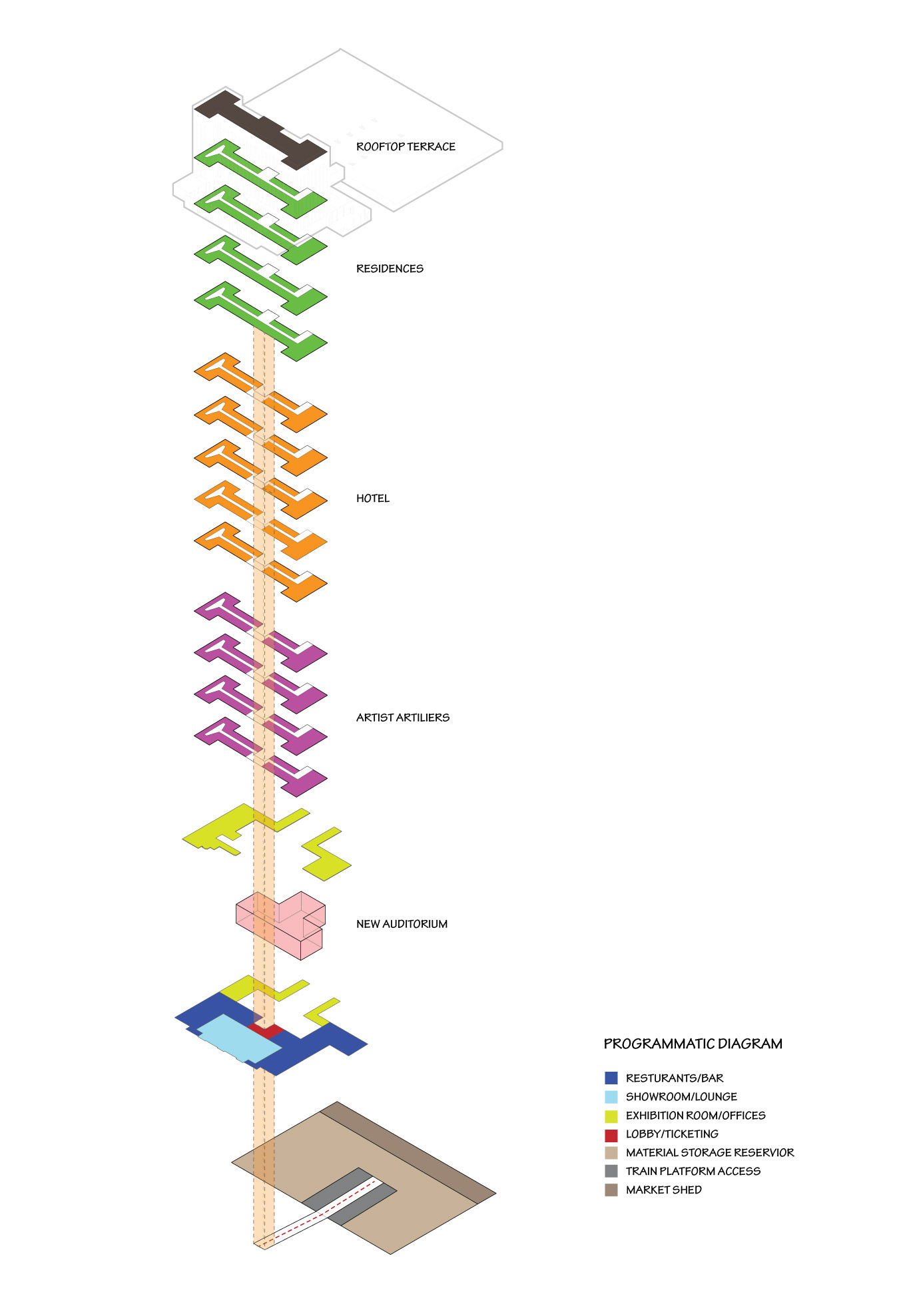Detroit Station for the Arts: D-Constructing MCS
Detroit. it was a place that personified the American spirit. Its citizens embodied the characteristics of making, innovation, creativity, and hard work. Now, this once prosperous post-industrial American metropolis is now caught in the flow of downward municipal change. As the city consolidates in an effort to survive, a neglected landscape of industrial cathedrals and civic palaces remain without purpose. Furthermore, thousands of homes are left to decay due to massive neglect. However, embedded in these relics are significant layers of urban history and a fertile well of viable materials waiting to be used in an inventive way.
Merging my graduate thesis project and a design competition, this project reaches for an answer to the question, “How can the retention of a places’ physical palimpsest and history be reconciled within the context of a city that must shrink?” The processes of urban deconstruction and critical adaptive reuse hold plausible solutions to this question. Combined with the same creative spirit that put this metropolis on the global map, Detroit once again makes the statement that it is a place where things are made. The abandoned stock of materials are harvested from the city’s barren landscape and stored in a materials reservoir programmed underneath the train platform of Michigan Central. Inspired artists and inventors can pull from this reservoir and use spaces within the station’s tower to create their works and install their interventions. The station itself is a representation of the deconstructive process as portions of the building are removed and stored in order to accommodate the new program - "A Station of the Arts." The result is a public display of Detroit’s history, its creative expressiveness, and its ability to re-invent itself using existing and neglected objects.
Detroit Abandoned Relics and Industrial Palaces


Across Detroit's barren landscape, there is a wealth of materials. These materials can be found a various scales; at the scale of the city, the scale of a site, and the scale of the building. This collection of material is often overlooked because of the unpolished conditions it is found in. But they are indeed viable, and when harvested , can be adapted into new uses and products. Above is a matrix of all the possible materials that can be harvested from these various scales. This taxonomy serves as the architectural foundation for invention and intervention, in sustainably renewing Michigan Central Station and the surrounding Corktown Neighborhood.

Site map of Detroit's Corktown Neighborhood around Michigan Central Station. Fronting Michigan Central Station, is Roosevelt Park, a park designed in the City Beautiful movement meant to highlight the grandeur of the Bueax Arts Station - not the neighborhood. One of the reasons for the station's current condition (there are many reasons), is the immense amount of undefined open space that surrounds the station, most of this space belonging to the "regal" Roosevelt Park.. This was the first issue that I attempted to solve.


Above: A must-have in revitalizing the Corktown neighborhood is establishing a clearly defined public space around its landmark, Michgian Central Station. Every good and well-functioning neighborhood has a spatial center which serves the community as a forum for exchange , commerce, culture, debate and integration. Establishing this kind of public space around such a distinguishable landmark is an urbanistic way to invite the interaction of people (not just urban explorers). This traffic will bring with it its businesses and ideas along with a desire to stay and live - an instance that is already starting to take hold. Above are my studies of the immediate area surrounding Michigan Central. This diagram series shows how researching current conditions as well as historical conditions can produce a narrative for the creation of new spaces and urban interventions.

Above: This diagram series speculates on the manifestation of public spaces around Michigan Central through phasing interventions. The principle idea is to establish the main public spaces first, demarcating a clear spatial center for the neighborhood. This public activity will spur development along other important edges and throughfares. Once the squares and streets are clearly defined and edges are well developed the in-filling of the rest of the neighborhood will complete the transformation.

Above: Michigan Central Station. A direct decedent of NYC's late Grand Central Terminal, MCS is arguabely the grandest of our nation's remaining regal train depots from the early 20th century. Designed by the same architects of Grand Central in New York, Michigan Central was at its height the midwestern headquaters of a complex rail network. Michigan Central was located in one of Detroit's most vibriant and sustainable working class neighborhoods. From is completion is has always towered over its surroundings. But because of the massive sizing requirements of the depot, much of the neighborhood was razed to accomodate the station. Other damaging interventions such as the construction of several freeways continued the decay. Now the abandoned landmark towers over blocks of barreness but also small pockets of the remaining neighborhood holding onto what's left of its history. There are dualities of degradation and regeneration here; of life and barreness; of old and new. It was these complex dichotomies that sparked my initial interest to study this area during my graduate studies. As with any experiment or expidition, there are elements of serendipity discovered along the way. This serendipity has matured that initial interest into an ongoing infatuation of the intersection between the new and old within urban environments.

Above: Michigan Central Station broken down into essentially two seperate building masses - A grand City Beautiful/Beuax Arts style train terminal on the bottom and a Chicago Style Office Tower on the top. Although both masses physically unite to form a single building, there are no spatial relationships between the uses. Each operates as its own entity. They even have their own strucutral systems. I saw this as an opportunity to create overlaps and spatial experiences within the station that would allow it to been seen in a different and more interesting way. Using the methodology of de-construction the interior bowels of the tower are architecturally excavated opening the top mass to the bottom. This newly formed vertical atrium through the tower merges with the horizontal axis of movement in the station below. The masses now function as a unified building both aesthetically and spatially.

Above: This diagram shows the complex layering of the building's uses and how they are all linked spatially by the carved atrium nested in the center of the tower. The majority of public uses are kept at the lower levels in the bottom mass, while the more private spaces are located in the tower mass. This program was further refined by the compeition mandate from that originally developed during my graduate studies.

Original Building Section

Above: Michigan Central Station is re-imagined as a much more cohesive network of spaces, both inside and outside of the building. Users arrive at a public square, then through the treshold of the building into a common area, then to an atrium which has spatial orientations in both the lateral and vertical directions. This is the epicenter. Here patrons choose their activity: traverse upstairs to the hotel or visit one of the creative spaces; purchase a ticket for a show in the new auditorium; or browse the tickers to see when your train arrives.

Above: Before and After views from the top floor of Michigan Central Station. From this vantage point a person can see the implied axis of the station, which points directly toward the Detroit Institute for the Arts and the Detroit Public Library in the New Center District. Downtown Detroit can also been seen. The bottom image is a sketch of how establishing a public square and defining the edges along this space accentuate this historical axis and perhaps transform the space in a way its City Beautiful planners intended it to be.

Above: The material source for 'new' architectural intervention is pulled from the pool of local deconstructed materials. In this instance items native to railroad construction were the focus. Using first principles thinking, the rail tracks are removed from its obvious function as an infrastructure for train transit and re-framed as an infrastructure for movement of any kind. By breaking down this function an exploration is possible in how these materials can be used in different ways but still sup-port its foundational principles of movement. The outcome was a monumental stair system composed entirely of neglected railroad items. The structural steel rails now become the rails of support for the vertical movement of people through a building. The treads of the stair consist of a couplet of wooden railway sleepers.

Stair-Rail details

Stair-Rail and Tread Details

Above -Before and After: Buildings at the size and scale of Michigan Central beg to be opened to the public. On the outside its towering presence attracts visitors from all over. The building itself is an education on Detroit’s regal history, past construction processes, and the public pride our nation once upheld in regards to rail travel. These images show the transformation of the defunct waiting room into a series of public lounges, working spaces, galleries and studios, allowing the public to once again interact with the building.

Above - Before and After: The vast spaces of industrial urban artifacts can hold a variety of civic/public functions to take advantage of the magnetic appeal these structures boast. This image set shows the transformation of what was once Michigan Central’s Women’s Room into a fabrication lab. The large spaces are conducive to making things and research into deconstructed materials. Perhaps classes can be held where members of the community can learn about deconstruction or any other skill. Maybe a local university can use the space for courses focused on building fabrication and the urban environment or perhaps other functions unrelated to the building industry. The possibilities are as expansive as the spaces themselves.

Above - Before and After: The former train concourse area is transformed into an auditorium for large lectures, performances and presentations. Access to the train platforms are now reached through a new subterranean tunnel that traverses underneath the auditorium. This intervention is another example of the complex and unique spatial relationships formed by reframing building uses and traditional rules of spatial sequencing.

Above: In the tower, a customized panel system was fabricated entirely out of materials deconstructed from Detroit’s abandoned building supply. The wall system combines harvested lumber and salvaged wood flooring into an assembly that fits within the rhythmic strucutral pattern of the tower. Attached to the building by a track system, the walls are able to move within the space providing the ability to accommodate various activities such as galleries and large exhibits. This part of the project re-frames the functions of both a refuse material and a space previously designed for office habitation.

Typical Gallery/Tower Floor Plans, showing the spatial flexibility the moveable panels allow. The panels can remain in a "closed" position creating a few long linear spaces. In an "open" condition, they can move laterally and rotate to create a variety of smaller spaces.


Above - Before and After: Through the intervention of a dynamic wall system made from deconstructed materials, the spaces inside the tower are transformed from neglected office space to enclaves for viewing and creating art as well as holding lectures.

Above - Before and After: The neglected storage spaces underneath the rail platforms at Detroit’s Michigan Central Station formerly housed luggage and mail. The station has no use for such a function today. However, through re-questioning and re-framing, a new and relevant purpose can be discovered. The station’s subterranean spaces are re-imagined as storage space for another commodity: deconstructed and reclaimed materials. Coupled with the station’s landmark civic status, such a function will aid in the regeneration of the entire area.
Final Board Submission for International Competition.

The design board I submitted in winter 2015 for the Arch Medium International Competition - DSFA (Detroit Station for the Arts).
